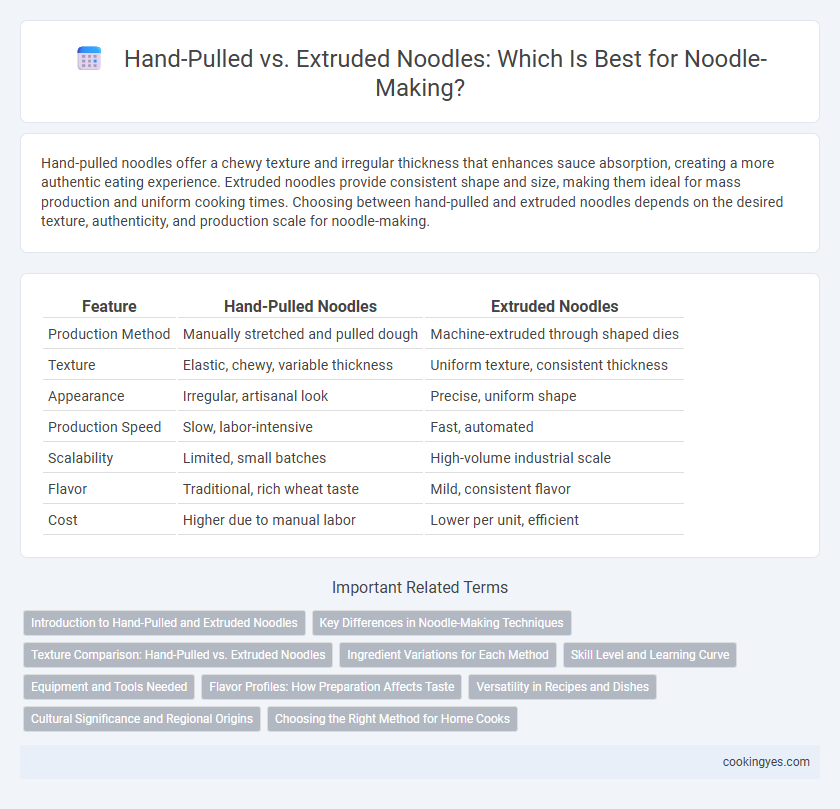Hand-pulled noodles offer a chewy texture and irregular thickness that enhances sauce absorption, creating a more authentic eating experience. Extruded noodles provide consistent shape and size, making them ideal for mass production and uniform cooking times. Choosing between hand-pulled and extruded noodles depends on the desired texture, authenticity, and production scale for noodle-making.
Table of Comparison
| Feature | Hand-Pulled Noodles | Extruded Noodles |
|---|---|---|
| Production Method | Manually stretched and pulled dough | Machine-extruded through shaped dies |
| Texture | Elastic, chewy, variable thickness | Uniform texture, consistent thickness |
| Appearance | Irregular, artisanal look | Precise, uniform shape |
| Production Speed | Slow, labor-intensive | Fast, automated |
| Scalability | Limited, small batches | High-volume industrial scale |
| Flavor | Traditional, rich wheat taste | Mild, consistent flavor |
| Cost | Higher due to manual labor | Lower per unit, efficient |
Introduction to Hand-Pulled and Extruded Noodles
Hand-pulled noodles are crafted by repeatedly stretching and folding dough to develop a unique chewy texture and irregular shape, showcasing traditional craftsmanship. Extruded noodles are produced by forcing dough through molds under pressure, resulting in consistent thickness and uniform shape suitable for large-scale production. Both methods influence the noodle's texture, cooking time, and flavor absorption, catering to diverse culinary applications.
Key Differences in Noodle-Making Techniques
Hand-pulled noodles involve stretching and folding dough repeatedly to create thin, chewy strands with an uneven texture, emphasizing craftsmanship and texture control. Extruded noodles are produced by forcing dough through molds using machinery, resulting in consistent shapes and faster production ideal for mass manufacturing. The key differences lie in texture, production speed, and artisanal quality, with hand-pulling enhancing elasticity and extrusion offering efficiency and uniformity.
Texture Comparison: Hand-Pulled vs. Extruded Noodles
Hand-pulled noodles exhibit a distinct chewy texture with a smooth, elastic bite due to the dough's stretched gluten strands, creating an artisanal mouthfeel that many noodle enthusiasts prefer. Extruded noodles tend to have a denser, firmer texture with slight ridges or grooves formed during the shaping process, which helps retain sauces and enhances flavor absorption. The choice between hand-pulled and extruded noodles significantly impacts the noodle's final texture, influencing culinary applications and sensory experience.
Ingredient Variations for Each Method
Hand-pulled noodles typically require high-gluten wheat flour to develop the dough's elasticity, enabling it to stretch without breaking, while extruded noodles often incorporate a wider range of flours, including rice and corn, to achieve different textures and flavors. Hand-pulled noodle recipes emphasize minimal ingredients such as water, salt, and high-protein flour, ensuring a chewy and smooth texture, whereas extruded noodles allow for the addition of various starches, eggs, or flavor enhancers like soy lecithin to improve processing and shelf life. Variations in ingredient composition directly influence the structural integrity and mouthfeel of the noodles produced by each method.
Skill Level and Learning Curve
Hand-pulled noodles require advanced skill and a steep learning curve due to the precise dough elasticity and pulling techniques needed for consistent texture. Extruded noodles offer a more user-friendly process, relying on machinery that shapes dough through dies, making them accessible to beginners with less manual dexterity. Mastery of hand-pulled noodles often takes years of practice, while extruded noodle production prioritizes efficiency and uniformity without extensive skill.
Equipment and Tools Needed
Hand-pulled noodles require minimal equipment, primarily a clean work surface and strong hands for stretching dough repeatedly to achieve the desired thinness and elasticity. Extruded noodles demand specialized machinery such as dough mixers, extruders, and cutters to shape the dough through dies into uniform noodle strands efficiently. While hand-pulled methods emphasize manual skill and simple tools, extrusion relies on industrial equipment for high-volume and consistent production.
Flavor Profiles: How Preparation Affects Taste
Hand-pulled noodles develop a chewier texture and richer gluten flavor due to the stretching process that aligns gluten strands, enhancing bite and mouthfeel. Extruded noodles typically have a denser, more uniform texture with a slightly bland taste profile, as the dough is forced through molds without gluten realignment. The traditional hand-pulling technique intensifies natural wheat flavors while extrusion favors consistency and mass production over complex flavor development.
Versatility in Recipes and Dishes
Hand-pulled noodles offer exceptional versatility in recipes due to their variable thickness and texture, making them ideal for soups, stir-fries, and cold dishes. Extruded noodles provide uniform shapes and sizes, ensuring consistent cooking times and suitability for mass production in pasta salads or baked dishes. The choice between hand-pulled and extruded noodles significantly impacts flavor absorption and overall dish presentation.
Cultural Significance and Regional Origins
Hand-pulled noodles, originating from China's Shaanxi and Lanzhou regions, carry deep cultural significance as a traditional craft requiring skilled artisanship and are often associated with family heritage and ceremonial meals. Extruded noodles, found across East and Southeast Asia, are produced using mechanical presses that shape dough through dies, reflecting industrial advancements and catering to mass consumption while maintaining regional variations like Korean ramyeon or Vietnamese pho noodles. Both types illustrate the intersection of culinary tradition and regional identity, with hand-pulled noodles emphasizing artisanal heritage and extruded noodles highlighting technological adaptation in noodle-making.
Choosing the Right Method for Home Cooks
Hand-pulled noodles offer a traditional, artisanal texture with uneven thickness that enhances sauce absorption, ideal for home cooks seeking authenticity and a tactile cooking experience. Extruded noodles provide uniform shapes and sizes with consistent cooking times, making them a practical choice for ease and efficiency in home kitchens. Selecting between these methods depends on desired texture, time investment, and available equipment, with hand-pulling requiring practice and skill, while extrusion simplifies the noodle-making process.
Hand-pulled noodles vs extruded noodles for noodle-making Infographic

 cookingyes.com
cookingyes.com